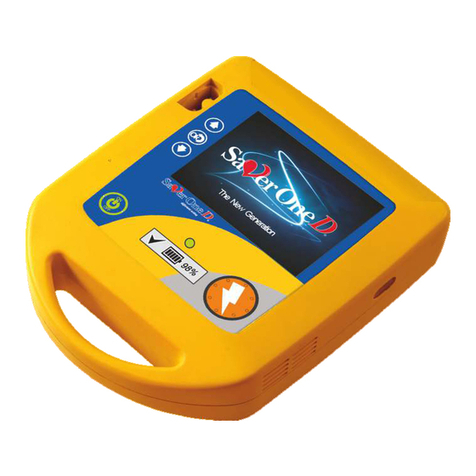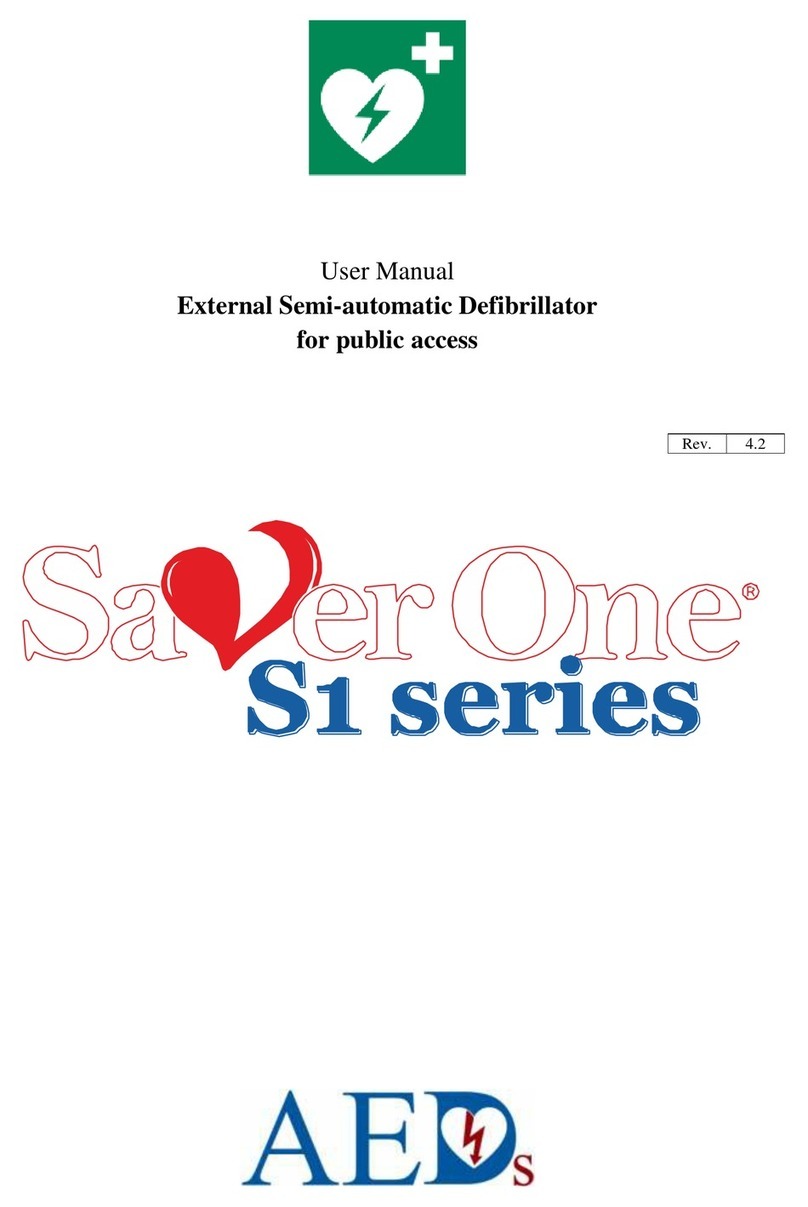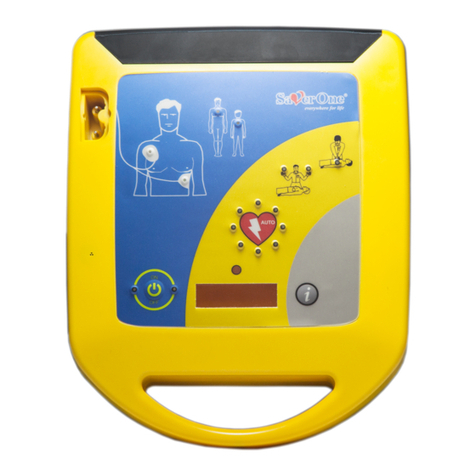AED CellAED User manual

SINGLE-USE AED 2
USER MANUAL
PEELSNAP STICK
SINGLE-USE AUTOMATED EXTERNAL DEFIBRILLATOR
Read the User Manual carefully before using the
CellAED® and keep it for future reference.

2
TABLE OF CONTENTS
01 OPERATING INSTRUCTION
MANUAL INFORMATION 4
1.1 Notice 4
1.2 Software license statement 4
1.3 Regarding this manual 5
1.4 Limits to manufacturer’s responsibilities 5
1.5 Indemnification 5
1.6 Compliance with local regulations 5
02 GLOSSARY 6
03 SYMBOLS USED IN THIS MANUAL / DEVICE 8
04 SAFETY INFORMATION 15
4.1 Responsibility of user and training
requirements 15
4.2 CellAED® intended use 15
4.2.1 What is sudden cardiac arrest? 15
4.3 CellAED® indications for use 16
4.4 Contraindications 16
4.5 Safety terms 16
4.6 Operation with other devices 16
4.7 Terms of Warranty 17
4.8 More Information 17
05 ABOUT CellAED® 18
5.1 The CellAED® 18
5.2 Capabilities and key features 18
5.2.1 Accessories 18
5.2.2 Simple Snap…Peel…Stick® operation 18
5.2.3 Automated operation 18
5.2.4 Continuous battery diagnostic 19
5.2.5 Heart rhythm analysis 19
5.2.6 Defibrillation waveform 19
5.2.7 Shelf Life 19
06 SHELF LIFE 20
6.1 Unpacking and inspecting the CellAED® 20
6.2 Packaging, instructions, controls, indicators
and labels 22
6.3 Storing the CellAED® 28
6.4 Maintaining the CellAED® 28
6.5 Disposing the CellAED® 31
07 HOW TO USE THE CellAED® 32
7.1 Pad placement and chest compression CPR
for patients weighing greater than 10 kg
(22 lbs) 32

3
7.2 Pad placement and chest compression
CPR for infants weighing less than 10 kg
(22 lbs) 32
7.3 What happens when I activate
the CellAED® 32
7.4 Responding to a sudden cardiac arrest using
the CellAED® on a patient weighing greater
than 10 kg (22 lbs) 35
Step 1 Assess safety of location 35
Step 2 Determine whether the
patient is in sudden cardiac arrest 35
Step 3 Call emergency services
immediately and retrieve the CellAED® 35
Step 4 Start chest compression CPR 35
Step 5 Prepare the patient for
treatment with the CellAED® 36
Step 6 Remove the CellAED®
from the packaging 37
Step 7 Defibrillate using the CellAED® 37
7.5 Responding to a sudden cardiac arrest using
the CellAED® on an infant weighing less than
10 kg (22 lbs) 40
Step 1 Assess safety of location 40
Step 2 Determine whether the infant
is in sudden cardiac arrest 40
Step 3 Call emergency services
immediately and retrieve the CellAED® 40
Step 4 Start chest compression CPR 40
Step 5 Prepare the Infant for
treatment with the CellAED® 40
Step 6 Remove the CellAED®
from the packaging 41
Step 7 Defibrillate using the CellAED® 42
08 VOICE PROMPT INSTRUCTIONS 44
09 TROUBLESHOOTING 50
10 TECHNICAL SPECIFICATIONS
AND INFORMATION 52
10.1 Technical terminologies / acronyms 52
10.2 Technical characteristics & specifications 53
10.3 Biphasic exponential waveform 56
10.4 ECG interpretation & performance 57
10.5 Guidance & manufacturer’s declaration –
Electromagnetic emissions & immunity 58
10.5.1 Electromagnetic emissions 58
10.5.2 Electromagnetic immunity 59
10.6 Recommended separation distance between
portable and mobile RF communications
equipment and the CellAED® 62
11 DANGERS, WARNINGS & CAUTIONS 64
12 CONTACTS 69

4
Read the Operating Instructions carefully before
using the CellAED® and keep it for future reference.
1.1 NOTICE
It is not permitted to reproduce or duplicate this
manual in any part without the permission of RRR
Manufacturing Pty Ltd, hereafter referred to as RRR.
All rights are reserved ©2020.
All images are Copyright Protected©: CellAED® is a
registered trademark of CellAED Life Saver Pty Ltd.
All Trademarks indicated in this document are
owned by CellAED Life Saver Pty Ltd.
Software in this product is copyrighted to RRR or
its vendors. All rights are reserved. The embedded
firmware and software shall not be copied,
decompiled, reverse-engineered, disassembled or
otherwise used in any way, and remain the property
of RRR.
1.2 SOFTWARE LICENSE STATEMENT
STM32 HAL Library is Copyright © ST Micro.
All Rights Reserved. This piece of software is made
available under the terms of the BSD Style license,
which can be found below.
CMSIS Arm Library is Copyright © ARM Limited.
All Rights Reserved. This piece of software is made
available under the terms of the BSD Style license,
which can be found below.
BSD LICENSE
Redistribution and use in source and binary forms,
with or without modification, are permitted provided
that the following conditions are met:
Redistributions of source code must retain the above
copyright notice, this list of conditions and the
following disclaimer.
Redistributions in binary form must reproduce the
above copyright notice, this list of conditions and
the following disclaimer in the documentation and/
or other materials provided with the distribution.
Neither the name of the copyright holder nor the
names of its contributors may be used to endorse
or promote products derived from this software
without specific prior written permission.
THIS SOFTWARE IS PROVIDED BY THE COPYRIGHT HOLDERS
AND CONTRIBUTORS “AS IS” AND ANY EXPRESS OR IMPLIED
WARRANTIES, INCLUDING, BUT NOT LIMITED TO, THE IMPLIED
WARRANTIES OF MERCHANTABILITY AND FITNESS FOR A
PARTICULAR PURPOSE ARE DISCLAIMED. IN NO EVENT
SHALL THE COPYRIGHT HOLDER OR CONTRIBUTORS BE
LIABLE FOR ANY DIRECT, INDIRECT, INCIDENTAL, SPECIAL,
EXEMPLARY, OR CONSEQUENTIAL DAMAGES (INCLUDING, BUT
NOT LIMITED TO, PROCUREMENT OF SUBSTITUTE GOODS OR
SERVICES; LOSS OF USE, DATA, OR PROFITS; OR BUSINESS
INTERRUPTION) HOWEVER CAUSED AND ON ANY THEORY
OF LIABILITY, WHETHER IN CONTRACT, STRICT LIABILITY, OR
TORT (INCLUDING NEGLIGENCE OR OTHERWISE) ARISING IN
ANY WAY OUT OF THE USE OF THIS SOFTWARE, EVEN IF
ADVISED OF THE POSSIBILITY OF SUCH DAMAGE.
For latest Free and Open Source Software
licensing info, please refer to the following URL;
www.rapidresponserevival.com/opensource
For latest company Privacy Policy, please refer to
the following URL;
www.rapidresponserevival.com/legal
01 OPERATING INSTRUCTIONS MANUAL INFORMATION

5
1.3 REGARDING THIS MANUAL
The contents of this manual are subject to change
without notice. All efforts have been made to ensure
that the contents of this manual are correct. If for
any reason the user suspects an error, please do not
hesitate to contact RRR at the address shown on
Section 12, page 69.
1.4 LIMITS TO MANUFACTURER’S
RESPONSIBILITIES
RRR Manufacturing Pty Ltd. is not responsible
for the safety and reliability of the CellAED® if
the CellAED® is not used in accordance with all
Instructions and danger, warning and caution notices
in this manual.
1.5 INDEMNIFICATION
RRR Manufacturing Pty Ltd. provides the following
indemnity to persons or legal entities that have
purchased a CellAED® from RRR or an authorized
distributor appointed by RRR (hereafter referred to as
“the Purchaser”).
RRR will, at its cost, defend, indemnify, and hold
harmless the Purchaser from third-party claims or legal
actions for liability or damages resulting from bodily
injury or death caused by a mechanical or electrical
failure of the CellAED®, or the malfunction of the
CellAED® due to a defect in its design or manufacture.
This indemnity does not extend to, or cover, any claim
or legal action for liability or damages in connection
with the use of the Purchaser’s CellAED® caused by:
- Negligent operation of the CellAED®, or failure
to follow the sequential operating instructions for
use of the CellAED®, or:
- Failures or malfunctions of the CellAED® that are
due to improper maintenance, including, without
limitation, malfunctions of electrode pads or
batteries that occur after expiration of their shelf
life, or malfunction of repairs, replacement parts,
pads, or batteries that were not provided by RRR.
This indemnification is expressly conditioned
on the Purchaser’s fulfilling the following
obligations with respect to any claim for which
indemnification will be requested (hereafter
referred to as “the Claim”). The Purchaser will
send it to RRR at the contact address shown
in Section 12, page 69 with written notice of
the Claim, promptly after the Purchaser obtain
knowledge of the Claim.
- The Purchaser also will provide to RRR all assistance
reasonably requested for evaluation of the Claim or
Defense of the Claim. Such assistance will include:
- Transferring possession of the CellAED® involved in
the Claim to RRR (including any electronic records
created by the CellAED® of the event involved in
the Claim) for analysis of the cause of any failure,
and providing to RRR and its counsel all other
evidence relevant to the Claim, whether in the form
of documents or testimony. RRR will promptly
notify the Purchaser in writing if RRR determines
that the Claim is not covered by this indemnity, and
RRR shall have the unrestricted authority to defend
or settle any Claims for which indemnification is
required by this agreement. However, the Purchaser
shall retain the right to participate, at its own
expense, in the defense or settlement of any Claim
that is covered by this indemnity.
All claims in respect of the above must be sent in a timely
manner by registered mail or by electronic mail (email) at
the Contact address in Section 12, page 69.
1.6 COMPLIANCE WITH LOCAL
REGULATIONS
All users must comply with any statutory and local
regulations and requirements associated with ownership
and use of a defibrillator in the region where it is to be
used; check with the Government Health Department
for this information. In case of a difference between the
regulations and these operating instructions, comply
with the regulations in the region of use.
Table of contents
Other AED Medical Equipment manuals
Popular Medical Equipment manuals by other brands

Getinge
Getinge Arjohuntleigh Nimbus 3 Professional Instructions for use

Mettler Electronics
Mettler Electronics Sonicator 730 Maintenance manual

Pressalit Care
Pressalit Care R1100 Mounting instruction

Denas MS
Denas MS DENAS-T operating manual

bort medical
bort medical ActiveColor quick guide

AccuVein
AccuVein AV400 user manual















